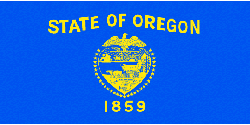 History Spanish and English sailors are believed to have sighted the Oregon coast in the 1500s and 1600s. Capt. James Cook, seeking the Northwest Passage, charted some of the coastline in 1778. In 1792, Capt. Robert Gray, in the Columbia, discovered the river named after his ship and claimed the area for the U.S. In 1805 the Lewis and Clark expedition explored the area. John Jacob Astor's fur depot, Astoria, was founded in 1811. Disputes for control of Oregon between American settlers and the Hudson Bay Company were finally resolved in the 1846 Oregon Treaty, in which Great Britain gave up claims to the region. Oregon has a $3.3 billion lumber and wood products industry, and an $859 million paper and allied manufacturing industry. Its salmon-fishing industry is one of the world's largest. In agriculture, the state leads in growing peppermint, cover seed crops, blackberries, boysenberries, loganberries, black raspberries, and hazelnuts. It is second in raising hops, red raspberries, prunes, snap beans, and onions. With the low-cost electric power provided by dams, Oregon has developed steadily as a manufacturing state. Leading manufactured items are lumber and plywood, metalwork, machinery, aluminum, chemicals, paper, food packing, and electronic equipment. Crater Lake National Park, Mount Hood, and Bonneville Dam on the Columbia are major tourist attractions. Other points of interest include the Oregon Dunes National Recreation Area, Oregon Caves National Monument, Cape Perpetua in Siuslaw National Forest, Columbia River Gorge between The Dalles and Troutdale, Hells Canyon, Newberry Volcanic National Monument, and John Day Fossil Beds National Monument.
|
Read this profile of Oregon to learn about the state's history, points of interest, and government. Also find interesting facts about each state, including the state's motto, symbols, and when it entered the union.




